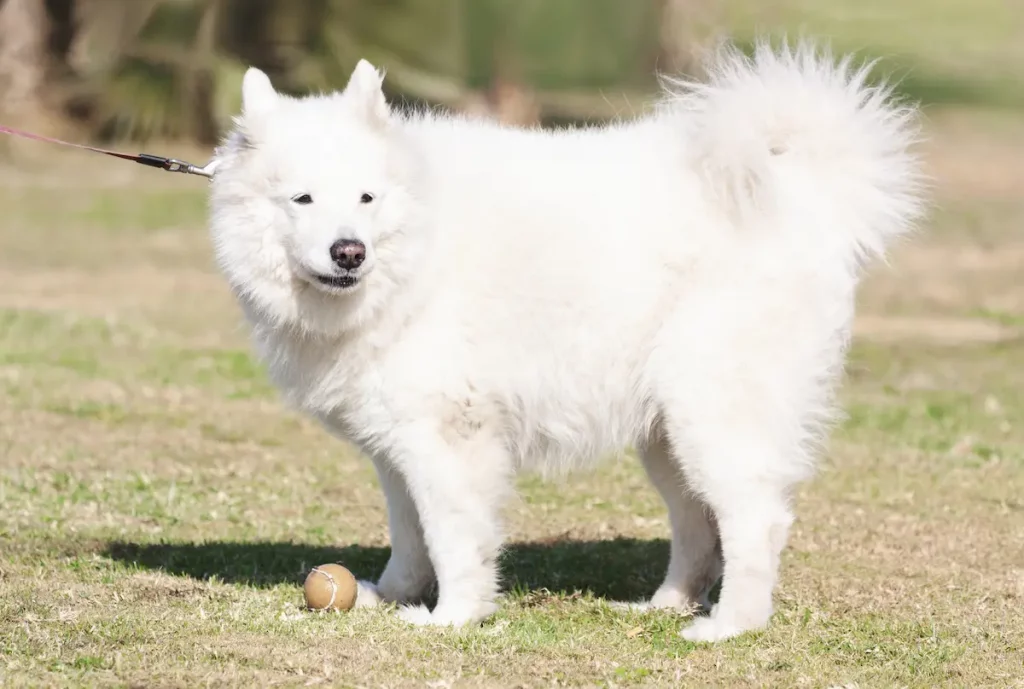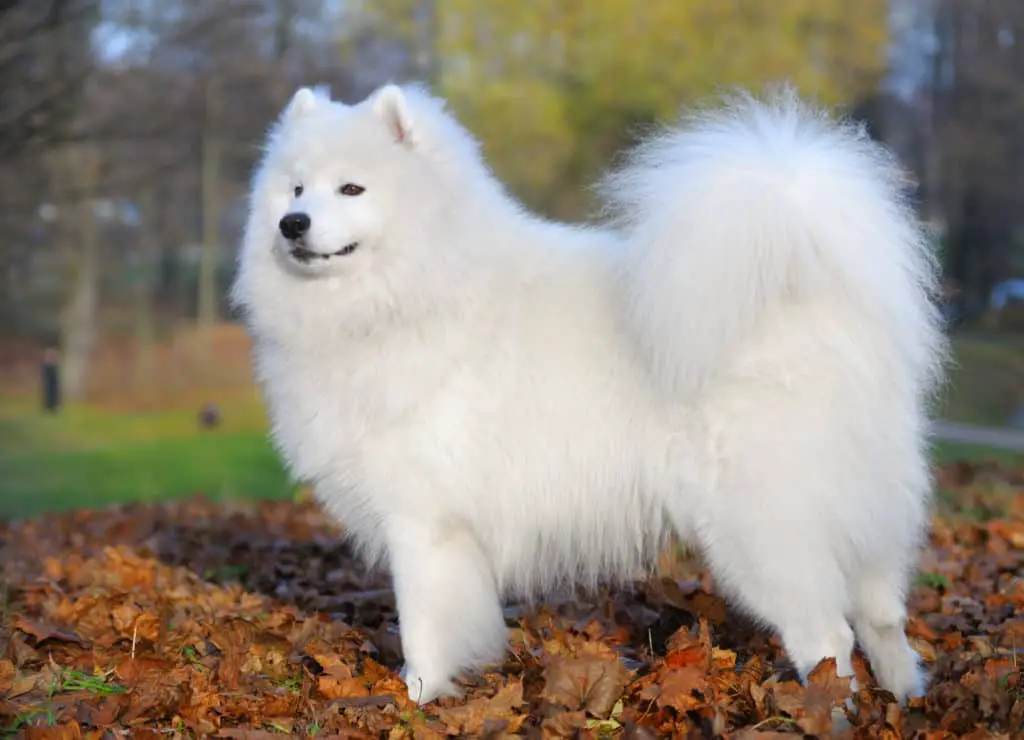Why Do Samoyeds Curl Their Tails? [FIND OUT!]
There are so many things that make Samoyeds simply adorable, and one of those is their tails.
Samoyeds were bred in Siberia and lived in arctic-like conditions for hundreds of years. They curl their tails because their furry tails were perfect for wrapping around their face and head to stay warm when laying down. When Sammies settle down to sleep on a cold night, they will curl up in a ball with their front paws folded next to their body and their tail clamped tightly to their body. The shape of a Samoyed’s tail allows it to have the end of its tail over its nose to keep it warm.
Samoyeds originated in cold climates. They are members of the Spitz family which includes many northern snow breeds. As Sammies originally come from sub-zero temperatures, they need extra protection against the elements.
This keeps them warm and prevents their tender noses from getting frostbit. This is a genetic quality that has been passed down through many generations. This is a common trait seen in many other northern breeds that were also exposed to such cold climates.

Related Reading: Best Dog Dryers For Samoyeds
What causes a Samoyed’s tail to curl?
The shape of the vertebrae plays a major role in lots of physical visible aspects of your Samoyed. For Samoyeds, the curl in their tails is caused by hemivertebrae.
The hemivertebrae condition or wedge-shaped vertebrae is a common trait in Samoyeds. This is a genetic or congenital condition in which the vertebrae in your dog’s tail formed it fused together in a curl or a wedge shape.
Did you know: A dog’s tail is a flexible continuation of a dog’s spine and is made up of many small bones. This contributes to a tail’s shape on the individual dog.
What does it mean when Samoyed tail is down?
Tails are a big way in which Sammies communicate with us. Dogs can’t use words, they use their tails to tell us when they are happy, sad, scared, and even injured.
When determining how your Samoyed is feeling, pay attention to the height of its tail. If it is held high then the dog is excited and alert, while a tail tucked close to the body might show fear and anxiety. If your Samoyed’s tail is down, there may be a few reasons why.
- They are relaxed and comfortable around you and their space
- Overexertion
- Exposure to cold weather or water
- Prolonged confinement
- Muscle injury
- Medical issues
Almost all Samoyeds will allow their tails to fall when they are relaxed and at ease or while eating. However, they will return their tails to a curl when more alert.
Tucking the tail between the legs signals submission and fear in Samoyeds. A tucked tail is equivalent to hiding your dog’s face because it covers the genitals and interferes with the sniffing behavior that identifies your Sammy to other dogs.
When do Samoyed puppies’ tails curl?
The Samoyed puppies stay normal and straight at birth. As the puppy grows up, the tail develops a curled shape. You can see Samoyed puppies’ tails slightly curl up at 2 to 3 weeks after birth.
As time passes the tail’s curl will be much more visible. In 5 to 6 weeks the tail should have gotten the signature curl shape of Samoyeds. It usually depends on the blood lineage and the parents of your Samoyed puppy.
If your Sammy puppy’s tail didn’t curl up even after a few months, take it to a vet for a thorough check-up.
Why is my dog’s tail not curly anymore?
A limber tail or cold tail is a condition in which active dogs suddenly develop a limp tail. The condition is usually due to a sprain or strain of the muscle groups supporting the tail.
Overexertion and strenuous physical activity are considered the underlying problem for the Limber tail. This causes damage to the muscles, ligaments, and tendons at the base of the tail.
As the tail is also used for balance, a dog with a limber tail may have difficulty getting up after lying down. Some dogs are unable to get comfortable when lying down. Pain is usually associated with a limber tail. So, the tail will droop and a dog won’t be able to wag it.
What dog breeds curl their tails up?
These breeds are quite well known for their curly tails.
- Akita
- Shiba Inu
- Pomeranian
- Pug
- Alaskan Malamute
- American Eskimo
- Norwegian Elkhound
- Keeshond
- Chow Chow
- Basenji
Why are Samoyeds always smiling?
The beautiful and charming “Sammy Smile” has a purpose. The upturned corners of the mouth keep the dog from drooling. Drooling would be impractical in a dog living in a harsh cold climate like Siberia. Drool would quickly freeze, becomes less pliable, and be more vulnerable to breakage.
“The lips should be black for preference and slightly curved up at the corners of the mouth, giving the Samoyed smile.” AKC

Are Samoyeds diggers?
Yes, Samoyeds will dig. Digging is a natural instinctive behavior for dogs and this is especially true for Samoyeds. In fact, they are excellent excavators and natural-born diggers by nature.
Sammies dig deep into the snow for protection against the bitter cold winds in their native land. For that case, they can be great “landscapers.”
There are ways to minimize digging so your yard and garden. Ensure your Samoyed is getting enough mental stimulation and physical exercise every day. This will help with boredom and provide more appropriate types of fun.
Final thoughts
Every dog is unique. Each of them has its own personality characteristics and special looks.
Regardless of Samoyed’s tail shape, there’s one thing for sure: the friendship, loyalty and love your Samoyed gives you can’t be beaten. With their striking white coat, fluffy tail, and sweet face, Samoyeds won’t need to ask for your attention twice.
Hope you enjoyed reading this article! Feel free to share your thoughts and questions. We would be happy to hear from you!

Family Dog Expert Author
Hi there! I’m Stuart, a devoted dog lover and family dog expert with over a decade of experience working with our furry companions. My passion for dogs drives me to share my knowledge and expertise, helping families build strong, loving bonds with their four-legged friends. When I’m not writing for SirDoggie, you’ll find me hiking, playing with my beautiful dog, or studying music.